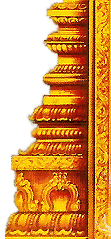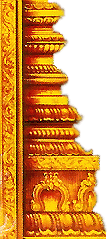|
|
Home >>
sivan >
sri Margabandeeswarar temple
|
| |
- Details
- Path
- Map
- Photos
- Near By Temple
| |
| Sri Margabandeeswarar temple |
|
| |
|
![[Image1]](http://img1.dinamalar.com/Kovilimages/T_500_828.jpg)
|
| | |
| | | |
|
|
|
Moolavar | : |
Margabandeeswarar |
|
|
Urchavar | : |
- | |
|
Amman / Thayar | : |
Maragadhambikai | |
|
Thala Virutcham | : |
Palm tree | |
|
Theertham | : |
Simha theertham | |
|
Agamam / Pooja | : |
- | |
|
Old year | : |
500-1000 years old | |
|
Historical Name | : |
Tiruvirinjipuram | |
|
City | : |
Virinjipuram | |
|
District | : |
Vellore
| |
|
State | : |
Tamil Nadu |
| |
|
|
| |
|
|
 | Singers: |  |
| |
|
|
| |
- |
|
| |
|
|
 |
Festival: |
 |
| |
|
|
| |
10 day Brahmmotsavam with flag hoisting and Theerthavari in in Panguni (March-April) when the presiding deity is taken on a procession in different vahans, last Sunday in the month of Karthikai (November-December) when over 2000 devotees will have a dip in Simha tank, Adipooram in July-August. Shivrathri in February-March, Navarathri in September-October, are the festivals grandly celebrated in the temple when devotee crowd would be huge. Other festival days include full moon days, monthly Pradoshams (13th day either from new moon or full moon days), Amavasya the new moon day, Kruthika star days each month, Sashti in October-November, Visakam in May-June, Thaipoosam in January-February, Sankatahara Chaturthi each month (4th day either from new moon or full moon days), Karthikai deepam in November-December. Special pujas are performed on Tamil and English new year days, Deepavali and Pongal days. |
|
| |
|
|
 |
Temple's Speciality: |
 |
| |
|
|
| |
The presiding deity is a swayambumurthi in a leaning form. The rays of Sun fall on the Lord in the month of Panguni (March-April). Palm tree is the sthala Vruksha of the temple which is in the inner corridor – prakara of the temple. This has a peculiar character of giving the fruits in black in a year and white the following year. The importance of the temple lies in the Rudraksha roof above the Sanctum sanctorum. Virinjipuram has also the reputation of being the birth place of renowned Vedic scholar and Shiva devotee, Sri Appayya Dikshithar. |
|
| |
|
|
 |
Opening Time: |  |
| | | | | |
The temple is open from 6.00 a.m. to 11.00 and 4.00 p.m. to 8.00 p.m. |
|
| | | |
 |
Address: |  |
| | | | | |
Sri Margabandeeswarar Temple, Virinjipuram, Vellore. |
|
| | | |
 |
Phone: |  |
| | | |
| |
| |
|
| | |
 |
General Information: |  |
| |
|
|
| |
According to history, the temple was built by Chola kings in 13th Century. |
|
| |
|
|
 |
Prayers |  | |
|
| | | |
The temple is noted for child boon prayer. It is the staunch faith of the devotees that taking the first bath in Palaru river followed by dips in Brahmma and Simha theerthas (tanks) and going round the deity ensures child boon. People also pray for timely marriages. Devotees also throng the temple for relief from the effects of witchcrafts occupying the family or the individual. | | |
|
| |  |
Thanks giving: |  | |
|
| | | |
Devotees perform abishek to Lord with gingely oil, turmeric, corn flours, milk, curd, fruits, sugarcane juice, honey. Panchamirtham – a mixture of items -, sandal, rose water and sacred ashes. They also perform aishek to Mother Maragamdhika with turmeric powder and offer Saris and dhoti to the Lord. They also arrange feeding the devotees and abishek with conches in the month of Karthikai covering November-December. The wealthy donate liberally for the maintenance and renovation of the temple. | | | |
| |  |
Greatness Of Temple: |  |
| |
|
|
| |
The presiding deity is slightly leaning on the Eesanya – Northeast direction symbolizing His grace to Lord Brahmma to see the head of the Lord. Earlier, Brahmma lied saying that he saw the head of the Lord in Tiruvannamalai. To make amends for the wrong, He worshipped the Lord in this temple. Brahmma came to the place as a boy and was initiated to Upanayanam (sacred thread ceremony) with Brahmmopadesa (teaching of the Gayatri Mahamantra) and Shiva Deeksha. The word Virinjan denotes Brahmma. As Brahmma worshipped here, the place is named Virinjipuram.
Rays of Sun fall on the presiding deity during the Panguni month (March-April).
The Lord accompanied a trader Danabalan by name as a companion to him. He is, hence, known as Vazhi (Marga or path) Thunai (companion or Bandhu in Sanskrit), Nathar (God).
The roof above the sanctum sanctorum is of Rudraksha – Rudraksha Pandal. The temple is an outstanding example of Tamil architectural skill. This is the birth place of renowned Vedic scholar and Shiva devotee Sri Appaya Dikshithar. |
|
| |
|
|
 |
Temple History: |  |
| |
|
|
| |
Brahmma the Creator had once to bear the effect of speaking a lie. Though he did not really see the head of Lord Shiva in Tiruvannamalai, unwilling to admit the failure, he used a flower (Thazhamboo) that fell from the head of Shiva and said that it was evidence of his seeing the head of the Lord. Lord Shiva did not want to give darshan to Brahmma in His real form. Brahamma was born to a priest in the temple named Shiva Sharman. After the death of the priest, he succeeded his father to serve the Lord.
After worshipping Swarna Ganapathi in the temple, Shiva Sharman came to the Lord for His abishek with the Tirumanjanam pot, but could not touch the head of the Lord as he was a boy. Merciful Lord bent His head to help the boy and acknowledged his services. Hence the Lord is found siding. He is in the same form in the name of Marga Bandhu Eeaswarar (a constant relation guiding us in the path of life). |
|
| |
|
|
 |
Special Features: |  |
| |
|
|
| |
Miracle Based:
The presiding deity is a swayambumurthi in a leaning form. The rays of Sun fall on the Lord in the month of Panguni (March-April). Palm tree is the sthala Vruksha of the temple which is in the inner corridor – prakara of the temple. This has a peculiar character of giving the fruits in black in a year and white the following year.
|
|
| |
|
|
|
| |
|
|
|
|
| | Location :
Bus facilities are comfortably available to devotees from Vellore to reach the temple.
Near By Railway Station :
Kadpadi and Vellore
Near By Airport :
Chennai
Accomodation :
Vellore:
Hotel Kanna: +91-416-222 3060, 222 3160
Hotel Darling Residency: +91-416-221 3001, 231 3005
Hotel Surabi International; +91-416-221 6399, 221 6499
Hotel Riverview: +91-416-222 5251, 222 2349.
| |
|
 |
|
|
|
|
|





